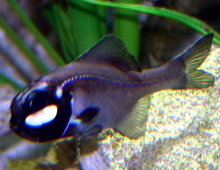Description: Flashlightfish, (Photoblepharon palpebratus) have a black body with a blue hue to its dorsal and caudal fins. They have a symbiotic relationship with glowing bacteria, which means that they need each other to survive. The fluorescent white to bluish-green glow under its eye comes from billions of bioluminescent or glowing bacteria that live under the fish’s skin in a bean-shaped light organ called a photophore. This ‘light’ helps the fish to hunt, navigate, avoid predators and communicate with one another. In return, the bacteria get a safe home, oxygen and nutrients from the blood of the Flashlightfish.
Size: Flashlightfish can grow up to five inches (12 cm) in length, with females being bigger than the males.
Behavior: The female protects the male from intruders. She will cover her light, swim up next to the intruder and then expose her light, scaring them into leaving. Schools of flashlight fish will escape their predator by blinking their lights, zigzag away and then blink again, thus making it impossible for predators to pick one of them out.
Diet: Flashlightfish eat zooplankton, small fish, crabs and shrimp.
Reproduction: External fertilization occurs. They usually spawn in pairs away from others. Approximately 600 eggs are produced by the female which float until they adhere to a substrate.
Habitat/range: They live along seaward reefs and along steep reef dropoffs in the warm waters of the Pacific Ocean, Indian Ocean and Red Sea. They are active at night; hiding during the day in caves.
Status: Not listed as of concern with IUCN or CITES.



